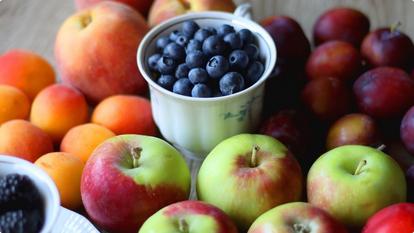Nutrition
Low-glycemic fruits: A sweet way to support steady blood sugar
Published: Jun. 5, 2025
Updated: Aug. 20, 2025
4 min read

The content in this article should not be taken as medical advice. Please consult with your healthcare provider regarding your individual health needs.
If you’re keeping an eye on your glucose levels, fruit might feel like a bit of a wild card. While fruit is natural, it’s also a carbohydrate. The good news is that not all carbs behave the same in your body. Low-glycemic fruits, in particular, are a great way to satisfy your sweet tooth while keeping your blood sugar steady.
Have you ever noticed how some fruits leave you feeling more balanced and satisfied than others? That's because different fruits will affect your glucose differently. That’s where something called the glycemic index comes in.
What is the glycemic index?
The Glycemic Index (GI) is a scale that ranks how quickly a food raises your glucose (blood sugar) after eating. The scale runs from 0 to 100:
- Low GI (55 or less): slower, steadier rise in glucose
- Medium GI (56–69): moderate impact
- High GI (70+): quicker spike
Low-GI fruits tend to digest more gradually, which causes less fluctuations in blood sugar (think of it as a flat street as opposed to a hilly one).

What about glycemic load?
Glycemic Load (GL) takes things one step further. It doesn’t just consider how fast a food raises glucose, but how much it raises it, based on a typical portion. Watermelon, for instance, has a high GI (76) but a low GL (4), so it’s not off-limits. Glycemic load is a good reminder that context and portion size matter.
Glycemic load values range from 0 to 100:
Low GL: 0 – 10
Moderate GL: 11 – 19
High GL: 20+
Low GL: 0 – 10
Moderate GL: 11 – 19
High GL: 20+
Low-glycemic fruits worth adding to the menu
These fruits offer a naturally sweet option with a gentler impact on blood sugar levels—especially when paired with other nutrients. Of course, it is important to consider what works best for your body.

Why low-GI fruits are worth it
Research shows that low-glycemic eating can improve glucose management, boost insulin sensitivity, and support optimal A1C levels over time. Low-GI fruits, in particular, can help smooth out post-meal glucose fluctuations, support better appetite regulation, and reduce glycemic variability. Over time, they may even contribute to lower inflammation and cardiovascular risk. In short, they’re a small shift that can make a big difference.

How to work low-GI fruits into your day
You don’t need to overhaul your diet, just be intentional about how (and when) you eat fruit. Here’s three simple tips:
1. Go for whole, not juiced or dried fruit
When you eat whole fruit, it takes longer to digest than drinking juice which will cause glucose to rise more gradually.
2. Pair it up
Combine fruit with protein, other fibrous foods, or fat—like yogurt, unsweetened nut butter, or seeds—to slow digestion.
3. Space it out
Spread fruit throughout your day, rather than loading up all at once.
A day in the life with low-GI fruit
Here’s how low-GI fruits might fit into a balanced day of simple, satisfying meals and snacks:
Breakfast: Plain Greek yogurt topped with ½ cup blueberries and chia seeds.
Lunch: Grilled chicken salad with greens, avocado, and half a grapefruit on the side
Snack: Sliced apple with almond butter
Dinner: Grilled salmon with roasted Brussels sprouts and quinoa, and a small bowl of strawberries for dessert

How Stelo can help
The glycemic index offers general guidance. But your body is unique, and so is your glucose response. That’s where Stelo comes in.
With Stelo, you can see exactly how your glucose responds to different fruits, meals, and combinations. It helps you understand your own particular patterns. That way, instead of guessing what works, you’re learning from your body.
Fruit doesn’t have to be off-limits. With insight and intention, it can be one of the most vibrant parts of your diet.

Curated & reviewed by: Cher Pastore,
MS, RD, BC-ADM, CDCES
MS, RD, BC-ADM, CDCES
Cher Pastore is a registered dietitian (RD) and Certified Diabetes Care and Education Specialist (CDCES).
